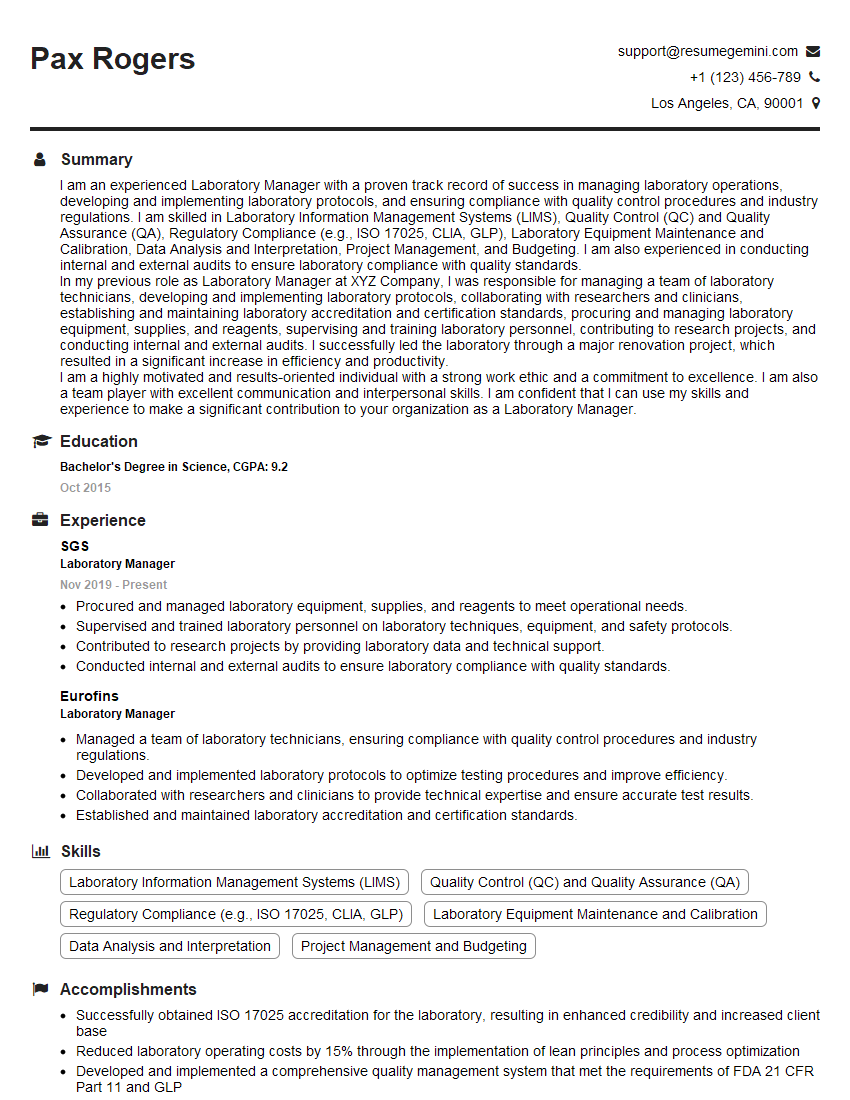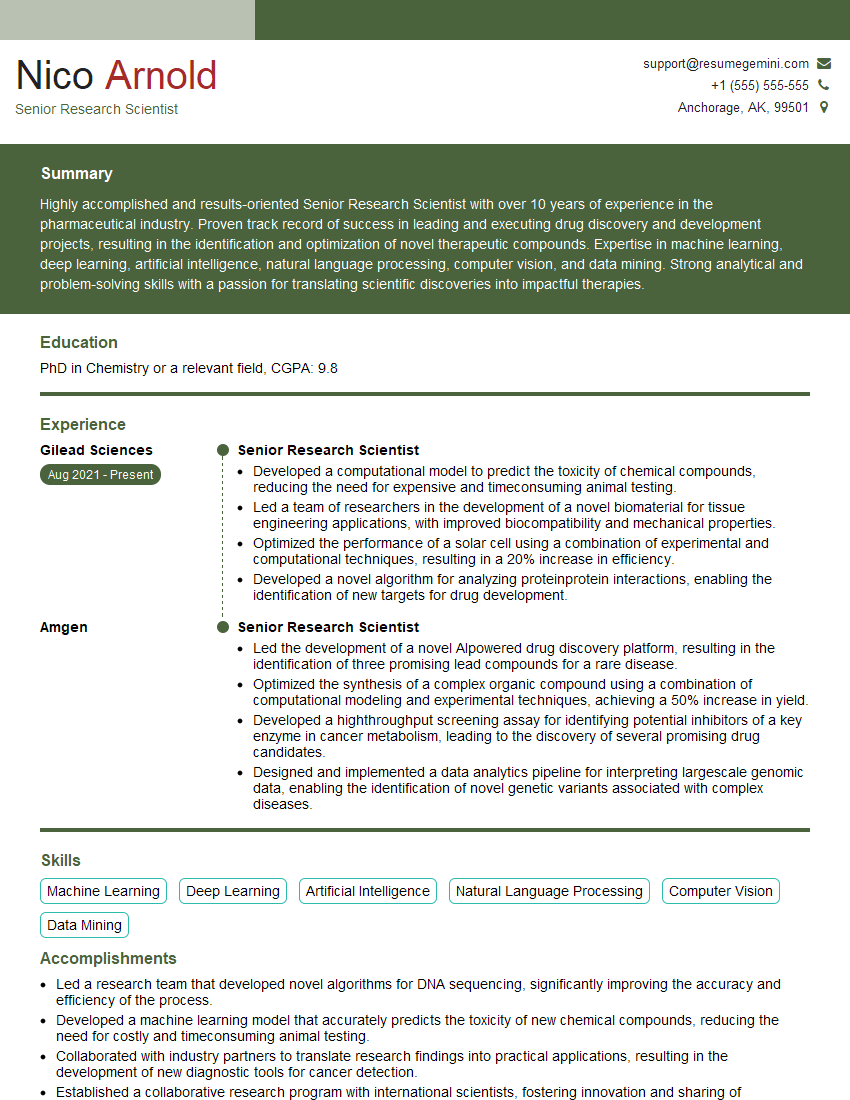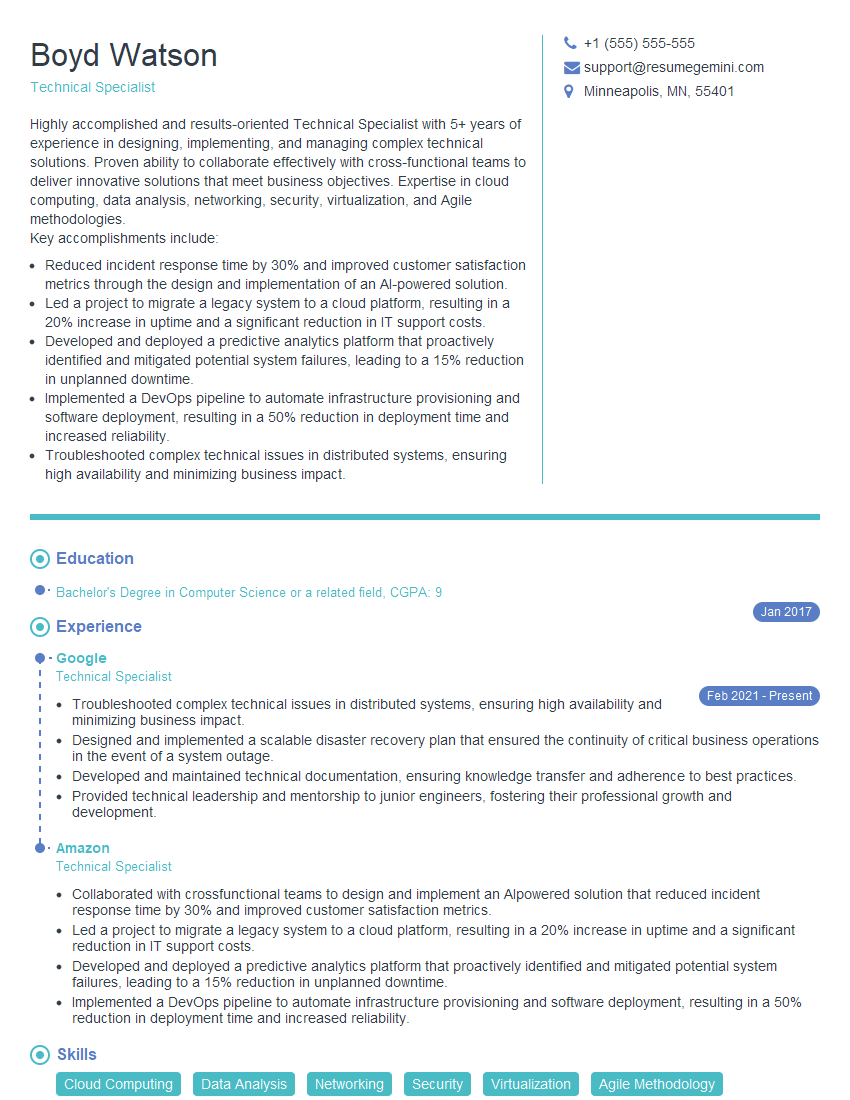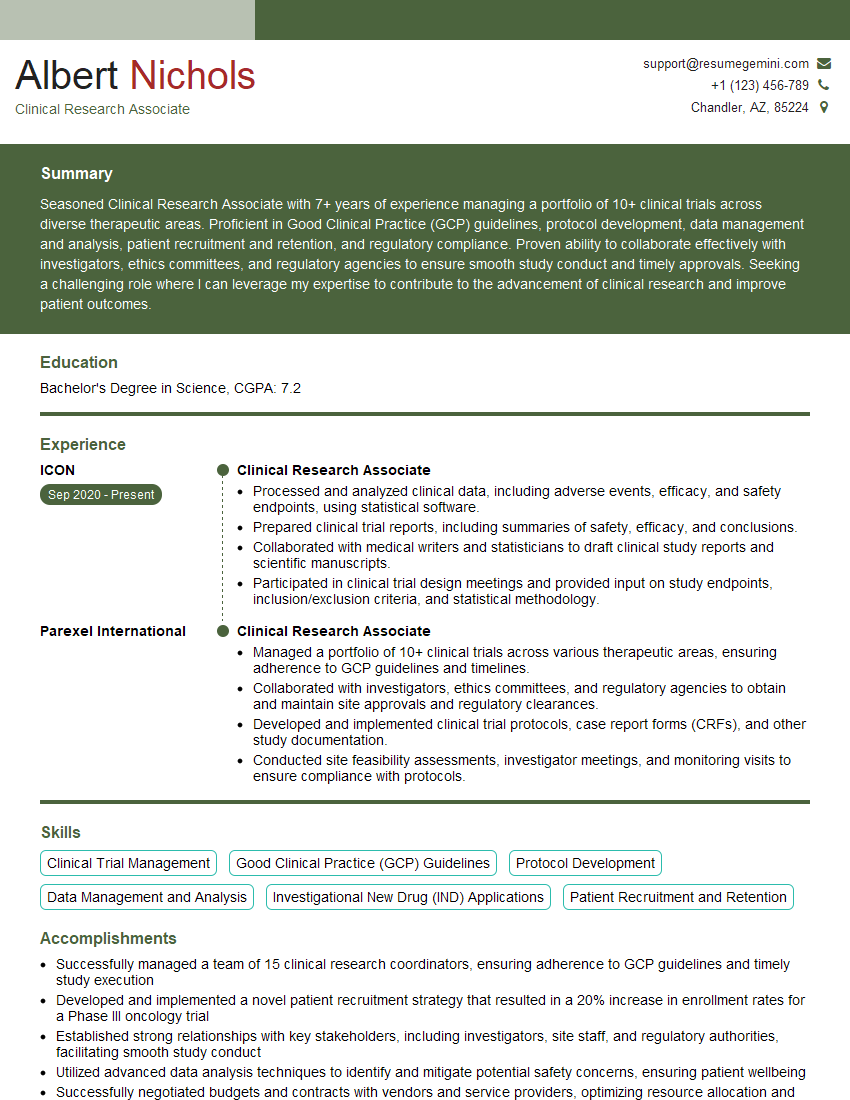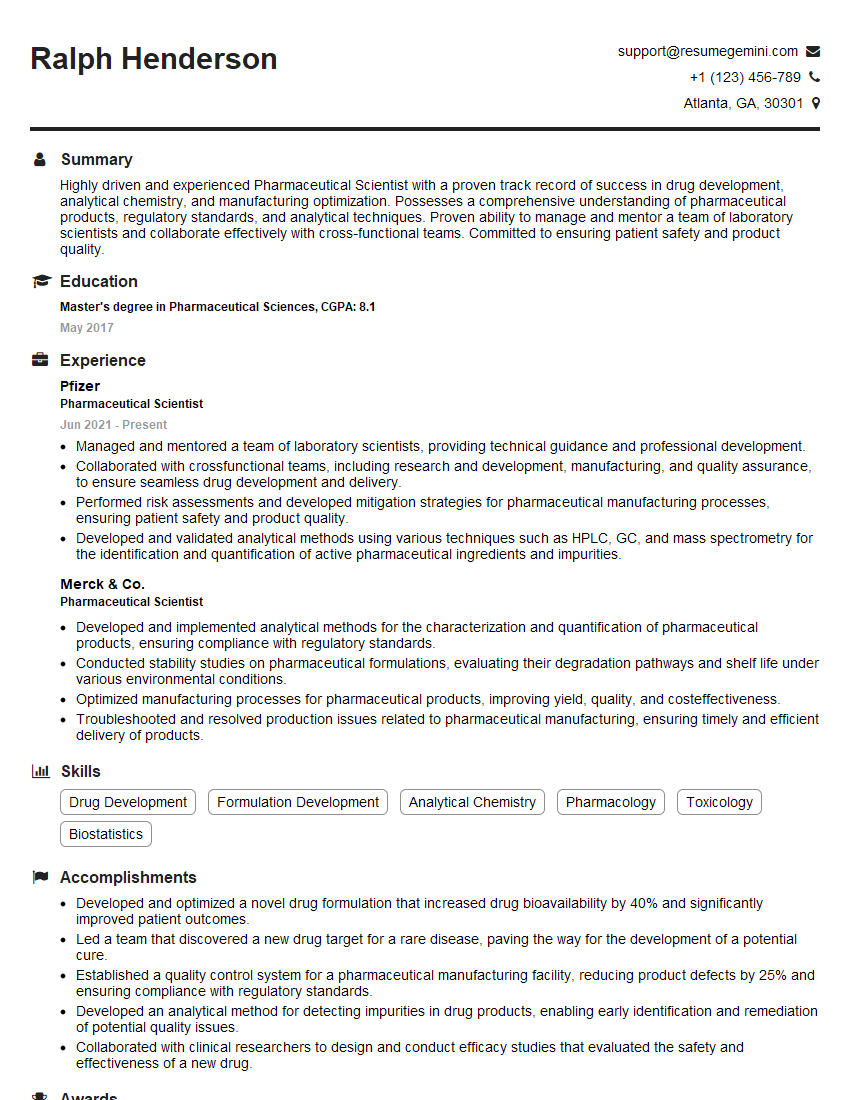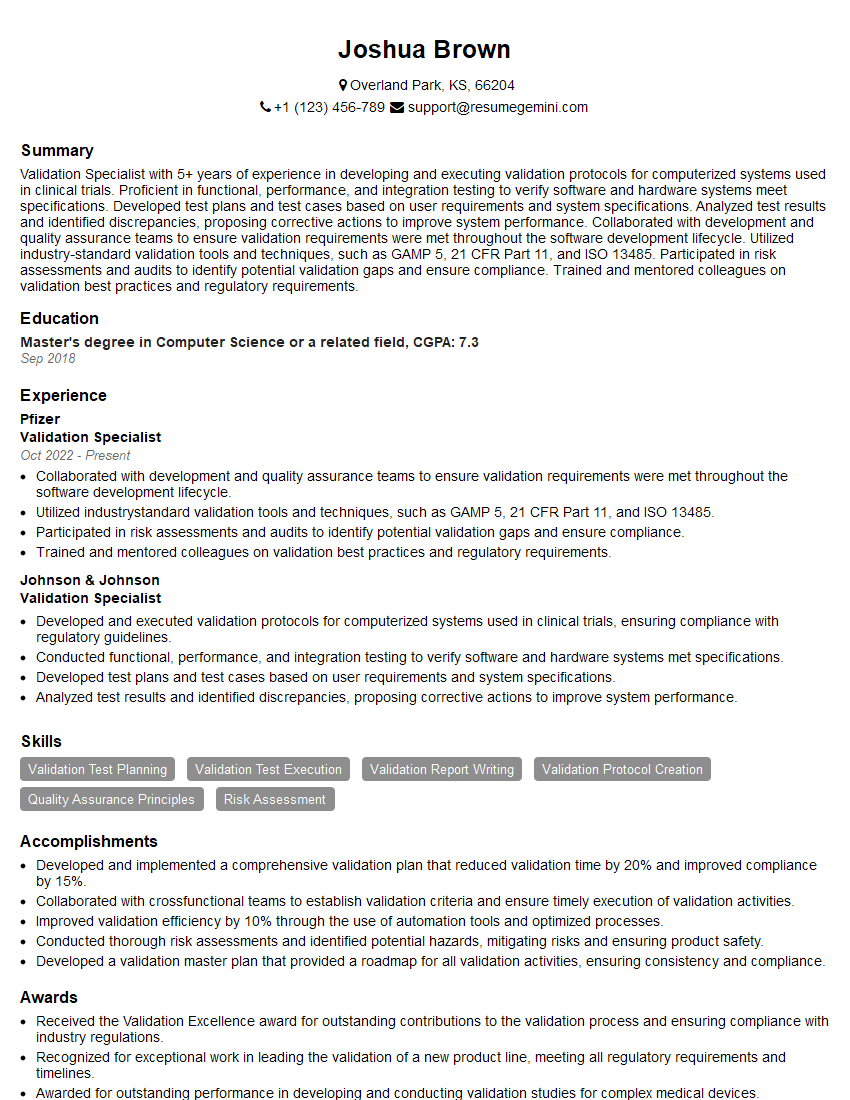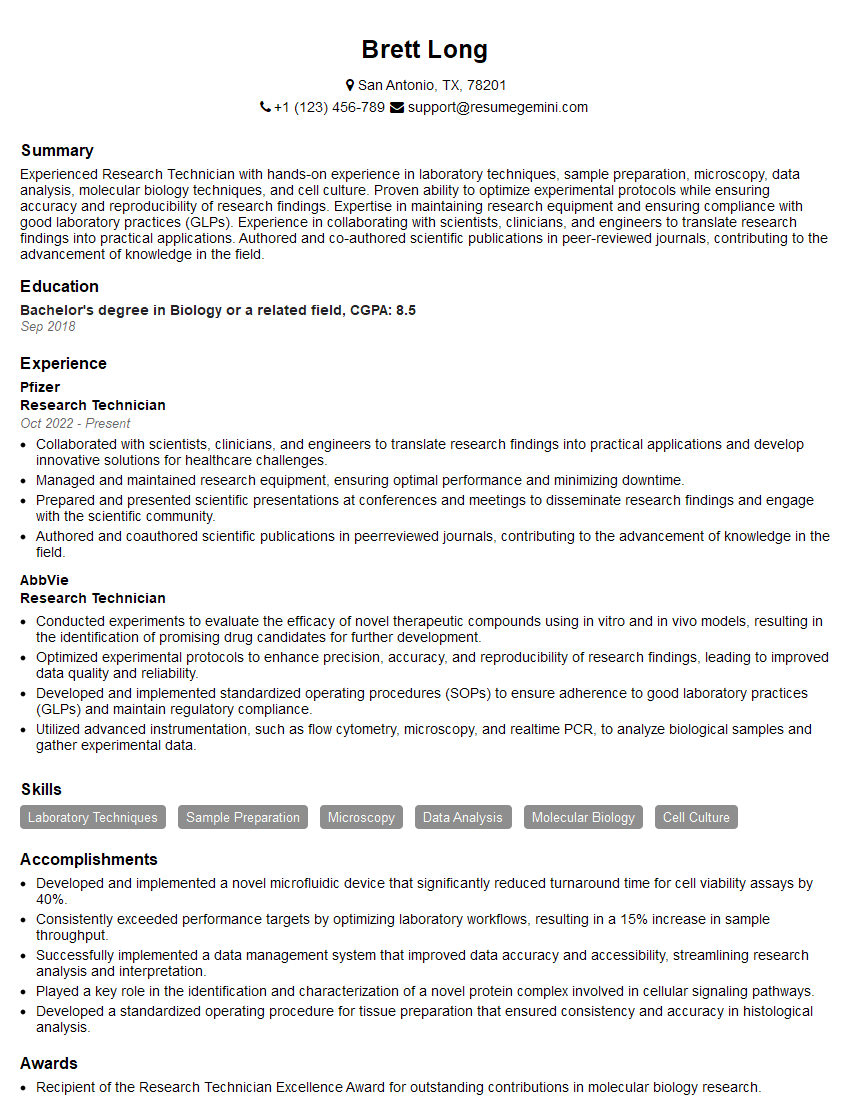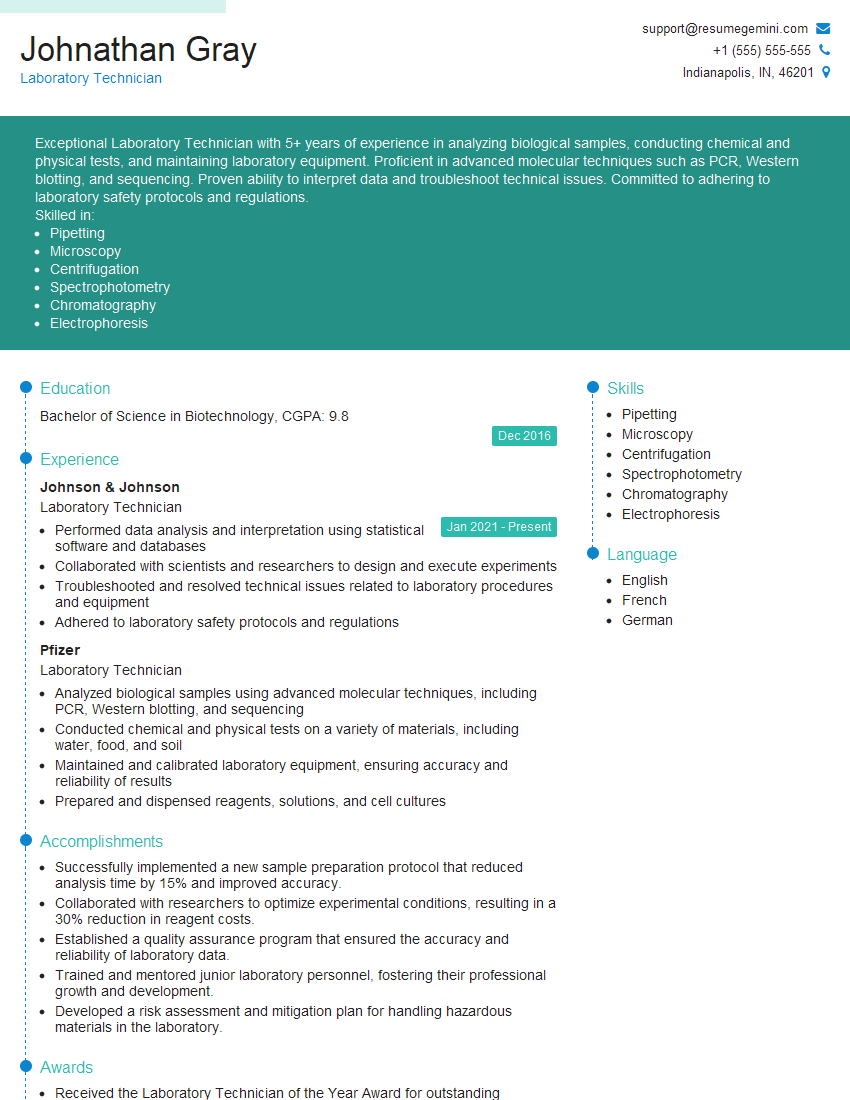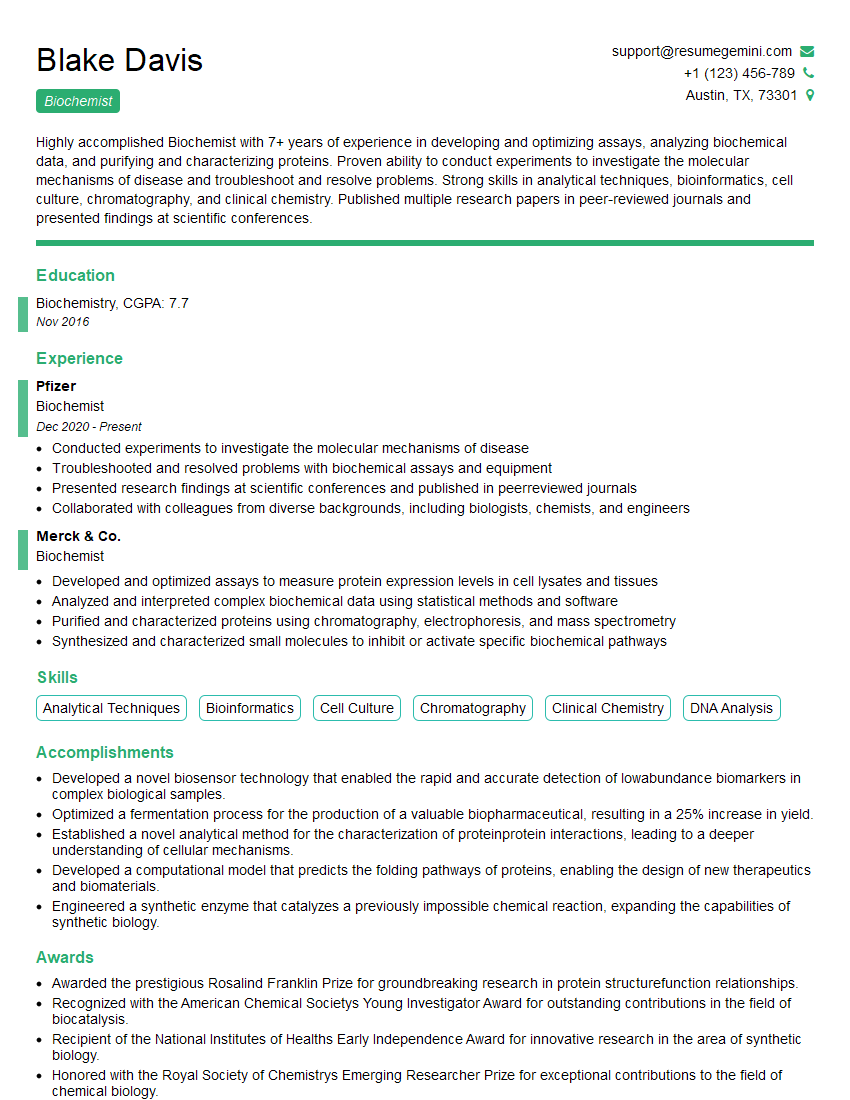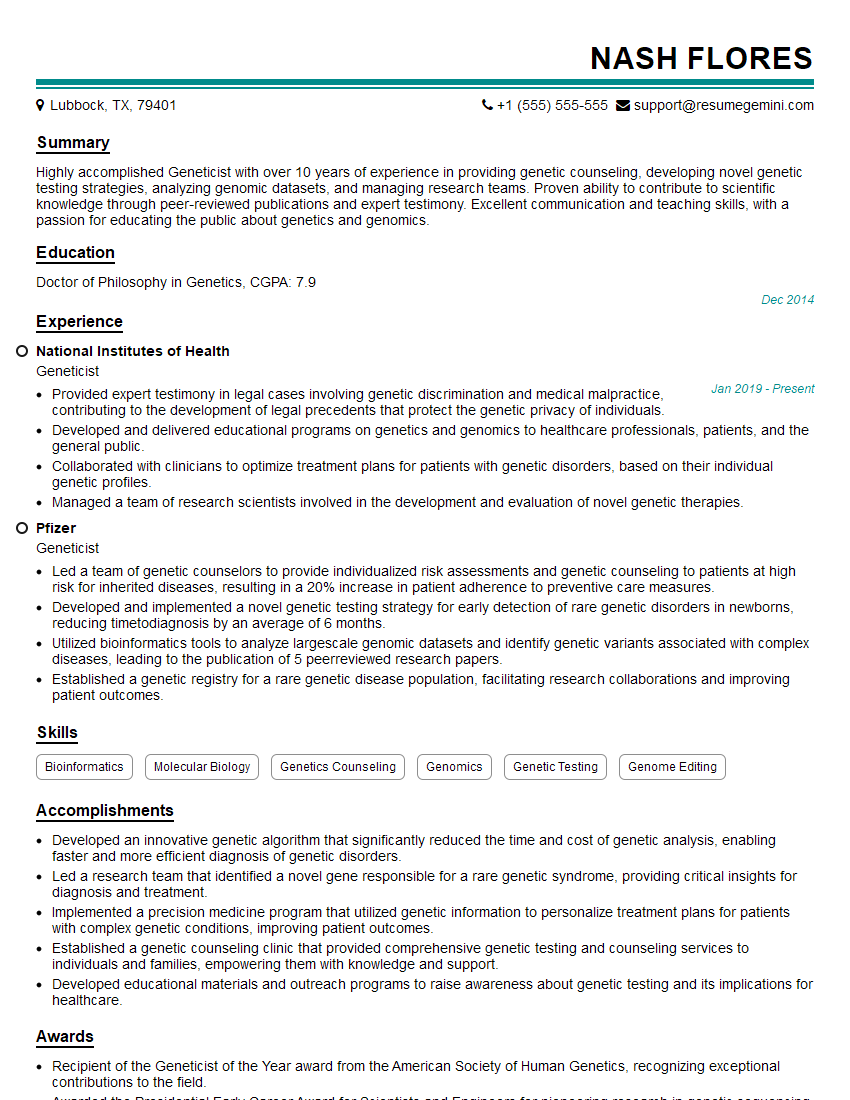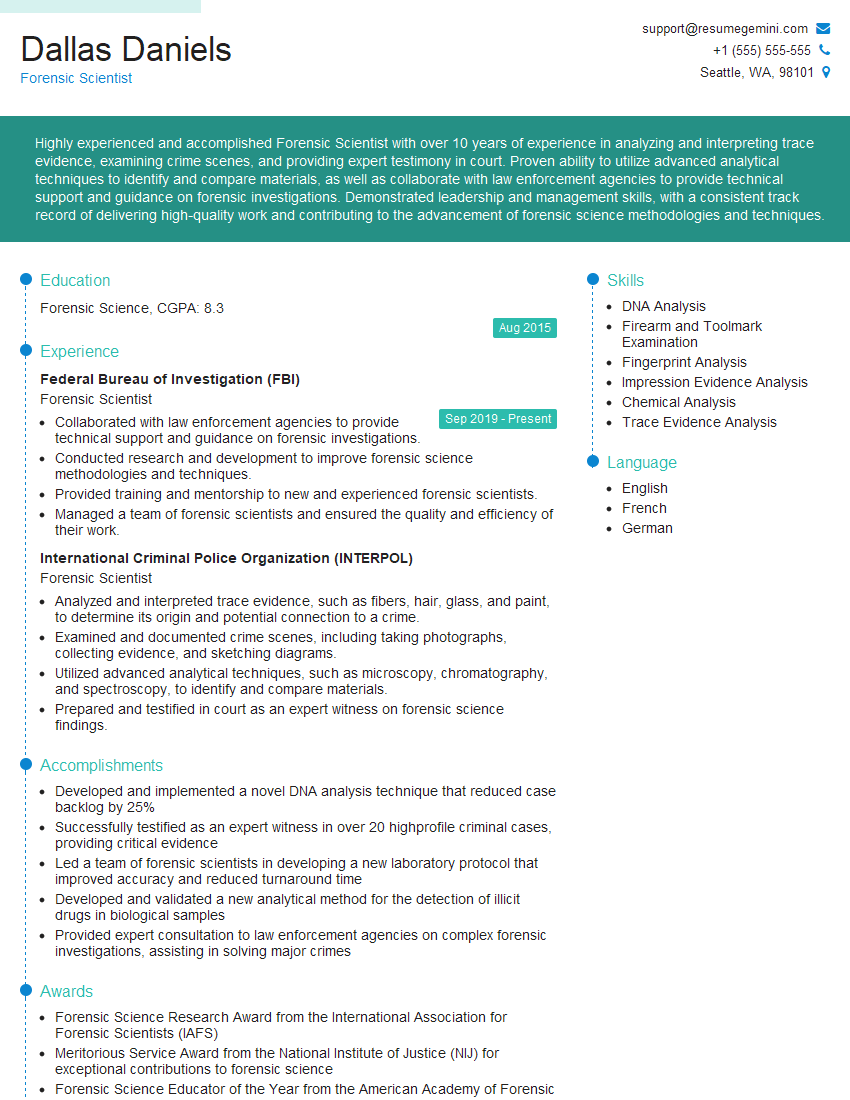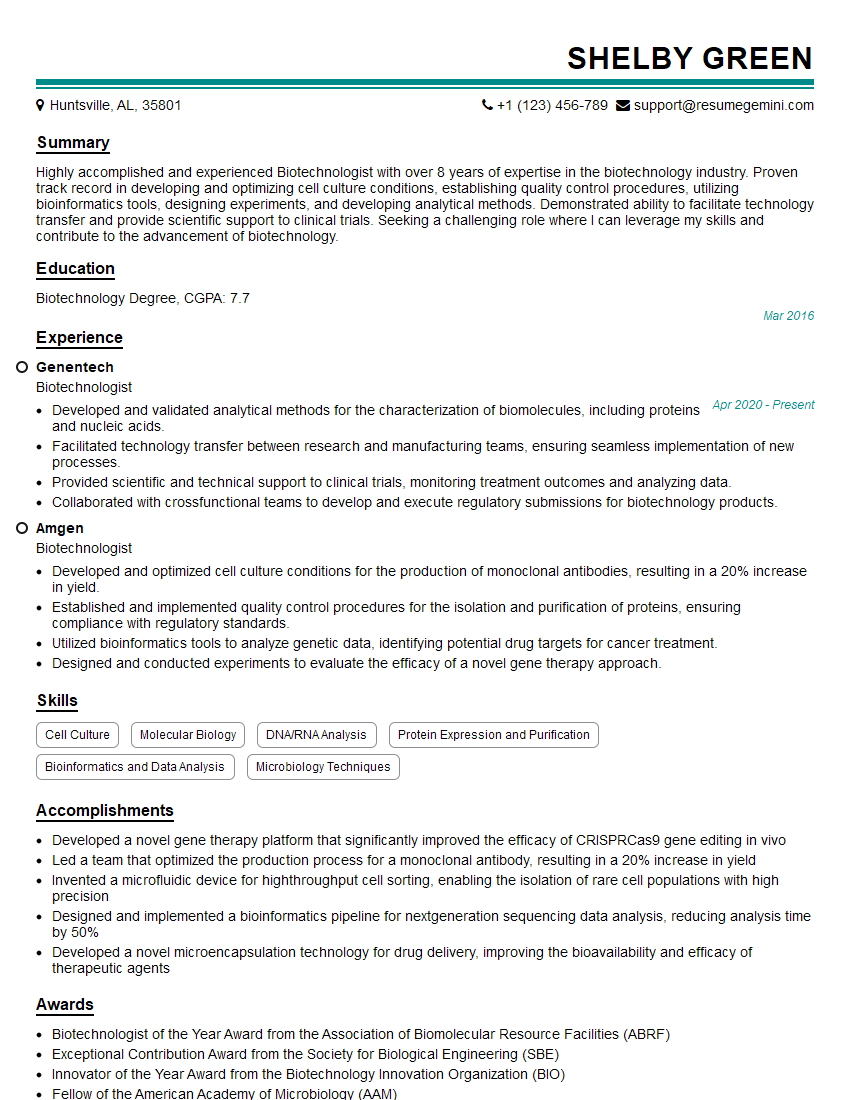Interviews are opportunities to demonstrate your expertise, and this guide is here to help you shine. Explore the essential Advanced Proficiency in Molecular Biology Techniques (PCR, qPCR) interview questions that employers frequently ask, paired with strategies for crafting responses that set you apart from the competition.
Questions Asked in Advanced Proficiency in Molecular Biology Techniques (PCR, qPCR) Interview
Q 1. Explain the principle of PCR.
PCR, or Polymerase Chain Reaction, is a revolutionary molecular biology technique that allows us to amplify a specific DNA sequence exponentially. Imagine you have a single grain of sand, representing your target DNA sequence, and you want a mountain of that sand. PCR is the process that lets you make that mountain. It does this by repeatedly making copies of your target DNA, resulting in millions or even billions of identical copies in a matter of hours. This amplified DNA can then be used for a variety of downstream applications, such as genetic testing, disease diagnosis, and forensic science.
Q 2. Describe the three steps in a PCR cycle.
A PCR cycle consists of three key steps, each occurring at a specific temperature:
- Denaturation (94-98°C): The double-stranded DNA template is heated to break the hydrogen bonds between the base pairs, separating the strands into single-stranded DNA. Think of it like unzipping a zipper. This allows the primers to access the DNA sequence.
- Annealing (50-65°C): The temperature is lowered to allow the primers to bind, or anneal, to their complementary sequences on the single-stranded DNA. The primers are short DNA sequences that act as starting points for DNA synthesis. This is like finding the ‘start’ point of your DNA sequence to begin copying.
- Extension (72°C): The temperature is raised to the optimal temperature for the DNA polymerase enzyme. The polymerase adds nucleotides to the 3′ end of the primers, extending them to create a new complementary DNA strand. This is where the actual copying takes place, essentially building a new strand from your template.
These three steps are repeated many times (typically 25-35 cycles), leading to exponential amplification of the target DNA sequence.
Q 3. What are the components of a PCR reaction mix?
A typical PCR reaction mix contains several crucial components:
- DNA Template: The DNA containing the target sequence to be amplified.
- Primers (Forward and Reverse): Short, single-stranded DNA sequences that flank the target region. They provide a starting point for DNA synthesis.
- dNTPs (deoxynucleotide triphosphates): The building blocks of DNA (A, T, C, and G). They are added by the polymerase to extend the primers.
- Taq Polymerase: A heat-stable DNA polymerase enzyme, typically derived from Thermus aquaticus bacteria, that can withstand the high temperatures of the denaturation step.
- Buffer: Provides an optimal environment (pH, salt concentration) for the polymerase enzyme to function effectively.
- Magnesium ions (Mg2+): A cofactor required by Taq polymerase for its activity. It acts like a helper molecule for the polymerase to function properly.
- Water: Makes up the bulk of the reaction volume.
Q 4. What is the purpose of a primer in PCR?
Primers are essential in PCR because they define the specific region of DNA to be amplified. They act as starting points for DNA synthesis by the polymerase enzyme. Without primers, the polymerase wouldn’t know where to begin copying the DNA. Think of primers as the address of the section of the genome we want to replicate.
Q 5. How do you design PCR primers?
Designing effective PCR primers is critical for successful amplification. Key considerations include:
- Specificity: Primers should bind only to the target sequence and not to other regions of the genome. We use software to check for off-target binding to ensure the reaction is accurate.
- Length: Typically 18-25 base pairs, providing sufficient specificity.
- Melting temperature (Tm): The temperature at which half of the primers are bound to their complementary DNA sequence. Primers should have similar melting temperatures for efficient annealing.
- GC content: Ideally around 40-60% for optimal stability and binding.
- Avoid self-complementarity and hairpin formation: This can prevent efficient primer binding.
- Avoid 3′ end mismatches: These can drastically decrease amplification efficiency.
Various software tools and online resources are available to aid in primer design, such as Primer3 and IDT SciTools.
For example, let’s say we are designing primers for a gene segment. We’d input the gene sequence into the software, specifying our desired parameters. The software will then suggest suitable primer sequences.
Q 6. Explain the difference between PCR and qPCR.
Both PCR and qPCR are amplification techniques, but qPCR (Quantitative PCR) offers a crucial additional feature: quantification. PCR simply amplifies DNA, while qPCR measures the amount of DNA amplified in real-time. Think of PCR as simply making copies, and qPCR as making copies and simultaneously counting those copies. qPCR uses fluorescent dyes or probes to detect the amplified DNA during each cycle, allowing for the quantification of the initial DNA template. This is especially useful for measuring gene expression, detecting pathogens, and various other quantitative applications where knowing the starting amount is important.
Q 7. What is the role of Taq polymerase in PCR?
Taq polymerase is a thermostable DNA polymerase, crucial for PCR’s success. It’s isolated from the bacterium Thermus aquaticus, which thrives in hot springs. Its heat stability is essential because the PCR reaction requires repeated cycles of high temperatures (denaturation) to separate DNA strands. Traditional DNA polymerases would denature and lose their function at these temperatures. Taq polymerase, however, remains active and can continue to synthesize DNA through multiple cycles. In essence, it’s the workhorse enzyme responsible for the actual amplification process by extending the primers to create new DNA strands.
Q 8. What are the different types of PCR?
PCR, or Polymerase Chain Reaction, isn’t just one technique; it’s a family of methods. The core principle remains the same – exponentially amplifying a specific DNA sequence – but variations exist based on the application and desired outcome. Here are some key types:
- Standard PCR: The foundational method, used for basic DNA amplification. It produces a large number of copies of a target DNA segment for various downstream applications, like cloning or sequencing.
- Reverse Transcription PCR (RT-PCR): This two-step process uses reverse transcriptase to convert RNA into complementary DNA (cDNA) before PCR amplification. This is crucial for studying gene expression, as it allows us to amplify RNA transcripts.
- Quantitative PCR (qPCR): This type allows for the quantification of the initial DNA or RNA template, measuring the amount of target sequence present in a sample. It’s essential for gene expression analysis, disease diagnostics, and pathogen detection.
- Nested PCR: Used to increase the specificity and sensitivity of PCR. Two sets of primers are used, with the second set amplifying a portion of the product generated by the first set. This minimizes non-specific amplification and enhances detection of low-abundance targets.
- Multiplex PCR: Simultaneous amplification of multiple target sequences in a single reaction. This is highly efficient for detecting multiple pathogens or studying multiple genes concurrently. It’s like running multiple PCRs simultaneously, saving time and reagents.
- Real-time PCR (qPCR, also called quantitative real-time PCR): This is a sophisticated type of PCR that allows for monitoring of the amplification process in real-time. The detection of amplicons (copied DNA) occurs at every cycle and allows you to measure the amount of starting material. This technique is widely used in research and clinical diagnostics.
Choosing the right type of PCR depends entirely on the research question and the specific application. For example, if you’re investigating gene expression levels, RT-qPCR would be the ideal choice.
Q 9. Describe the principle of qPCR.
qPCR, or quantitative PCR, measures the amount of DNA or RNA present in a sample during the PCR amplification process. Unlike standard PCR, which only provides information about the presence or absence of a target sequence, qPCR provides quantitative data. This is achieved by detecting the fluorescence emitted by a reporter molecule that binds to the amplified DNA. The amount of fluorescence is directly proportional to the amount of amplified DNA, which in turn is proportional to the starting amount of template DNA or RNA. The process monitors the amplification in real-time, cycle-by-cycle, providing a precise measurement of the initial amount of template.
Imagine you are baking cookies; standard PCR would only tell you if you have cookies or not. qPCR, on the other hand, will tell you exactly how many cookies you started with by monitoring the cookie dough increasing in size with each step of baking.
Q 10. Explain the different methods of qPCR data analysis (e.g., ΔΔCt method).
Several methods exist for analyzing qPCR data, each with its strengths and limitations. The most common methods include:
- ΔΔCt Method: This relative quantification method compares the expression level of a target gene in different samples. It uses a reference gene (housekeeping gene with consistent expression) to normalize for variations in sample loading or RNA extraction efficiency. The formula is: ΔΔCt = (Cttarget gene – Ctreference gene)sample – (Cttarget gene – Ctreference gene)control. A positive ΔΔCt indicates increased expression compared to the control, while a negative value indicates decreased expression.
- Absolute Quantification: This method involves creating a standard curve using known concentrations of the target sequence. By comparing the Ct values of the unknown samples to the standard curve, we can determine the absolute quantity of the target sequence in the samples.
- Standard Curve Method: Uses a dilution series of known concentrations of the target sequence to generate a standard curve. The Ct values are then plotted against the log of the concentration. The unknown sample’s Ct value is used to determine its concentration by interpolating it on the standard curve.
The choice of method depends on the experimental design and the information needed. For comparing gene expression between different samples, the ΔΔCt method is preferred. For determining the absolute copy number of a target sequence, absolute quantification is required.
Q 11. What is a standard curve in qPCR and how is it used?
A standard curve in qPCR is a graph plotting the Ct (cycle threshold) values against the known concentrations (or copy numbers) of a serially diluted standard DNA or RNA sample. This curve is essential for absolute quantification. The standard curve enables us to determine the concentration of an unknown sample by comparing its Ct value to the curve. A good standard curve has a high R2 value, indicating a strong correlation between Ct values and concentrations.
Think of it as a calibration curve for your qPCR reaction. Just like a kitchen scale needs to be calibrated to accurately measure ingredients, a standard curve calibrates your qPCR machine to accurately measure the amount of your target DNA.
Q 12. How do you determine the efficiency of a qPCR reaction?
The efficiency of a qPCR reaction reflects how effectively the target sequence is amplified in each cycle. Ideally, the amplification doubles in each cycle, leading to 100% efficiency. However, this is rarely achieved in practice. Efficiency is calculated from the slope of the standard curve using the following formula: Efficiency = 10(-1/slope) – 1. An efficiency between 90% and 110% is generally considered acceptable. Low efficiency suggests problems with the reaction, such as primer design, enzyme activity, or template quality, warranting optimization. High efficiency may also cause problems and indicates that there might be issues with the amplification.
Q 13. What are some common sources of error in PCR and qPCR?
Both PCR and qPCR are susceptible to various errors, leading to inaccurate or unreliable results. These include:
- Contamination: Presence of unwanted DNA or RNA in the reagents or equipment can lead to false positive results.
- Primer Dimers: Primers can anneal to each other, leading to non-specific amplification and consumption of reagents.
- Non-specific Amplification: Primers can bind to non-target sequences, leading to the amplification of unwanted products.
- Inhibitor Presence: Substances in the sample (like heme in blood samples) can inhibit the PCR reaction.
- Incorrect Reaction Conditions: Variations in temperature, MgCl2 concentration, or dNTP concentrations can greatly influence the PCR reaction.
- Template Degradation: Degraded DNA or RNA will yield poor amplification and skewed results.
Careful experimental design, use of appropriate controls (positive and negative), and meticulous laboratory techniques are essential to minimize these errors. Regular maintenance of equipment is also crucial for accuracy.
Q 14. How do you troubleshoot non-specific amplification in PCR?
Non-specific amplification, where primers bind to unintended sequences, is a common problem in PCR. Here’s how to troubleshoot it:
- Primer Redesign: The most effective solution is often redesigning the primers to improve their specificity. Tools like Primer-BLAST can assist in this process, ensuring that the primers only bind to the target sequence.
- Optimize Annealing Temperature: Increasing the annealing temperature can enhance specificity. A gradient PCR can help determine the optimal annealing temperature for your primers.
- Increase Primer Concentration: This can sometimes help improve the specific amplification, but it should be carefully optimized, as it might also enhance non-specific binding if done incorrectly.
- Use Hot-Start Polymerase: Hot-start polymerases prevent primer dimers and non-specific binding by only becoming active at higher temperatures.
- Check MgCl2 Concentration: An optimized magnesium chloride concentration in the reaction mix is important to enhance specificity.
- Use a Touchdown PCR: This involves starting PCR at a high annealing temperature and gradually lowering it in subsequent cycles, thereby increasing the specificity.
Remember to carefully analyze the size of the amplification products obtained using gel electrophoresis to determine the presence of unwanted products.
Q 15. How do you troubleshoot low amplification in PCR?
Low amplification in PCR can be frustrating, but systematic troubleshooting is key. Think of PCR like a recipe – if one ingredient is off, the whole thing fails. We need to check several aspects:
- Template DNA quality and quantity: Is your DNA degraded? Is there enough of it? Run a spectrophotometer analysis (e.g., Nanodrop) to check concentration and purity (A260/A280 ratio). If the DNA is degraded, consider using a different extraction method. If the concentration is too low, increase the amount of template added to the reaction.
- Primer design: Poorly designed primers are a common culprit. Are your primers specific enough to avoid non-specific binding? Are they the right length and melting temperature (Tm)? Are there potential primer dimers forming? Use online tools to check primer design. Redesign primers if necessary.
- Reaction components: Did you add all the necessary reagents? Are they fresh? Double-check the concentration and quality of your dNTPs, MgCl2, and polymerase. Magnesium ion concentration is particularly critical for polymerase activity. Incorrect MgCl2 can dramatically affect your results. Expired reagents can be another cause. Always ensure freshness and proper storage.
- Thermal cycling conditions: Incorrect annealing temperature is a frequent issue. The annealing temperature should be optimized to allow for specific binding of primers. Too high a temperature means your primers won’t bind; too low, and they’ll bind nonspecifically. Use a gradient PCR to optimize the annealing temperature. Also ensure that the extension time is sufficient for your amplicon length.
- Contamination: Contamination with PCR inhibitors or previous amplicons can lead to weak or absent bands. Always use sterile techniques and use positive and negative controls to detect contamination. A common contaminant is carryover from previous reactions, for which using dedicated reagents and a clean workspace is crucial.
Troubleshooting involves systematically eliminating these possibilities one by one. For instance, if you suspect primer problems, try a different primer pair; if you suspect reagent issues, use a fresh batch. Keeping detailed records of each step is crucial for effective troubleshooting.
Career Expert Tips:
- Ace those interviews! Prepare effectively by reviewing the Top 50 Most Common Interview Questions on ResumeGemini.
- Navigate your job search with confidence! Explore a wide range of Career Tips on ResumeGemini. Learn about common challenges and recommendations to overcome them.
- Craft the perfect resume! Master the Art of Resume Writing with ResumeGemini’s guide. Showcase your unique qualifications and achievements effectively.
- Don’t miss out on holiday savings! Build your dream resume with ResumeGemini’s ATS optimized templates.
Q 16. How do you troubleshoot high background signal in qPCR?
High background signal in qPCR, often manifested as a high baseline fluorescence, means your signal is noisy and makes it difficult to accurately quantify your target. The culprits are similar to PCR, but with a focus on fluorescence issues:
- Primer dimers: Primer dimers can generate a substantial background signal. They amplify nonspecifically, leading to an increase in the baseline fluorescence. Design primers carefully to minimize the possibility of dimer formation.
- Non-specific amplification: Your primers might be binding to other regions of the genome, leading to nonspecific amplification. Optimize your reaction conditions (especially annealing temperature) to reduce this. Try using a more stringent annealing temperature.
- Contamination: Similar to PCR, contamination with DNA or RNA can lead to increased background signals. Always use proper aseptic techniques, dedicated reagents and equipment, and include both positive and negative controls.
- Reagent quality: Degraded reagents or incorrect concentrations can negatively affect your results and amplify nonspecific signals. Fresh reagents and appropriate concentrations are critical.
- Passive reference dye issues: Issues with the passive reference dye (ROX) used for normalization can lead to artificially high readings. Ensure proper dilution and handling of the reference dye.
- Sample preparation: The presence of PCR inhibitors in your samples can also increase background fluorescence. Ensure proper DNA/RNA extraction and purification.
Troubleshooting involves checking these factors sequentially. For example, if you suspect primer dimers, redesign your primers or use a different primer set. If you suspect reagent quality, try a fresh batch. Record-keeping is crucial for tracking down the source.
Q 17. Explain the concept of melting curve analysis in qPCR.
Melting curve analysis in qPCR is a powerful post-PCR technique used to assess the specificity of the amplification reaction. It works on the principle that double-stranded DNA (dsDNA) denatures (separates into single strands) at a specific temperature, the melting temperature (Tm). The Tm is dependent on the DNA sequence.
In qPCR, after amplification, the temperature is slowly increased while monitoring the fluorescence. As the dsDNA melts, the fluorescence decreases. The resulting curve shows the temperature at which the amplicons melt, providing information on the specificity of amplification.
How it works: A dye, typically SYBR Green, binds to dsDNA. As the temperature increases, the dsDNA denatures, causing a decrease in fluorescence. This decrease is monitored and plotted against temperature. A single, sharp peak indicates a specific product, while multiple peaks or a broad peak suggest the presence of non-specific products (primer dimers, etc.).
Practical application: Melting curve analysis is crucial for validating the specificity of qPCR assays, especially those using SYBR Green. It helps to confirm that the amplified product is indeed the target gene and not a non-specific product. This is crucial for accurate quantification.
Q 18. What are the advantages and disadvantages of using SYBR Green vs. TaqMan probes in qPCR?
Both SYBR Green and TaqMan probes are popular choices for qPCR, each with its advantages and disadvantages:
- SYBR Green:
- Advantages: Less expensive, simple to use, requires only one dye.
- Disadvantages: Lower specificity, susceptible to non-specific amplification, requires melting curve analysis for validation.
- TaqMan probes:
- Advantages: Higher specificity, reduced background signal, no need for melting curve analysis, allows for multiplex reactions.
- Disadvantages: More expensive, more complex to design and synthesize, probe design is crucial for optimal performance.
Choosing the right method: SYBR Green is suitable for applications where cost is a major concern and high specificity is not paramount, but thorough validation using melting curve analysis is mandatory. TaqMan probes are preferred when higher specificity and accuracy are needed and/or multiplex assays are required, even though this comes with a higher cost.
Example: If I needed to screen a large number of samples for a specific gene, the cost-effectiveness of SYBR Green might be favored. However, if I was studying gene expression with subtle changes or multiple genes, the higher specificity of TaqMan would be preferable, despite the increased cost.
Q 19. Describe different methods for DNA extraction and purification.
DNA extraction and purification are critical steps before PCR or qPCR. The method chosen depends on the source material and downstream application.
- Phenol-chloroform extraction: A classic method, involves separating DNA from other cellular components using phenol and chloroform. This provides highly purified DNA, but is time-consuming and requires hazardous chemicals.
- Salting-out method: This simpler method uses high salt concentrations to precipitate proteins, leaving DNA in solution. It is less expensive and quicker than phenol-chloroform, but purity might be slightly lower.
- Column-based purification: Commercial kits utilize silica-based columns to bind DNA, allowing for separation from other cellular components. These are quick, easy to use, and readily available, but more expensive than other methods.
- Magnetic bead-based purification: Similar to column-based purification, but uses magnetic beads coated with silica to bind DNA. These methods are highly automated and high-throughput, ideal for large-scale applications.
- Chelex extraction: A rapid method using Chelex resin to chelate metal ions and inhibit DNases, releasing DNA into solution. Simple, fast, and suitable for small-scale extractions, but DNA yield might be lower.
Choosing a method depends on several factors, including the sample type (blood, tissue, bacteria, etc.), the amount of DNA needed, the available resources, and the required purity. For example, I’d likely use a column-based kit for routine PCR, but phenol-chloroform for particularly pure DNA needed for advanced analyses.
Q 20. How do you ensure the accuracy and reproducibility of your PCR and qPCR results?
Ensuring accuracy and reproducibility in PCR and qPCR requires meticulous attention to detail at every stage. Think of it like baking a cake – if you don’t follow the recipe precisely, you won’t get consistent results.
- Standard operating procedures (SOPs): Having detailed SOPs for every step ensures consistency. This includes DNA extraction, PCR/qPCR setup, analysis, and data interpretation.
- Positive and negative controls: These are essential for verifying the success of the reaction and detecting contamination (discussed in the next question).
- Calibration curves: In qPCR, generating calibration curves using known quantities of target DNA allows for accurate quantification of unknown samples. This ensures that your measurements are reliable and reproducible.
- Appropriate replicates: Including technical and biological replicates minimizes experimental error and allows for statistical analysis. Technical replicates are multiple PCR reactions from the same DNA sample; biological replicates are from different samples of the same group.
- Data analysis: Use appropriate statistical analysis methods to evaluate the significance of your results. Consider the limitations of your methods and potential sources of error.
- Regular maintenance and calibration of equipment: Calibrating your thermocycler and other equipment is essential for accurate and reproducible results.
For instance, I always use the same pipettes for a batch of experiments to avoid variations caused by different pipettes’ calibration and I always record all experimental details in a lab notebook along with digital record-keeping.
Q 21. What is the importance of positive and negative controls in PCR and qPCR experiments?
Positive and negative controls are indispensable in PCR and qPCR experiments to validate the results and detect contamination. They are like a quality control check for your experiment.
- Positive control: This contains known quantities of the target DNA, confirming that the PCR/qPCR reaction is working correctly and that the reagents and equipment are functioning properly. It serves as a benchmark to ensure the conditions are suitable for amplification.
- Negative control: This lacks the target DNA and serves to detect contamination. If the negative control shows amplification, it indicates contamination in the reagents or equipment, necessitating repetition of the experiment with fresh reagents and a cleaned workspace.
Example: If I am running a PCR for a specific gene, my positive control would contain a plasmid or genomic DNA known to contain that gene. My negative control would be a reaction mixture identical to the others except it lacks any added template DNA. A positive control showing no amplification or a negative control showing amplification points to significant issues that need troubleshooting.
The inclusion of positive and negative controls is essential for interpreting results confidently. Without them, any amplification could be attributed to contamination, making the experiment’s outcome unreliable.
Q 22. Explain the concept of real-time PCR kinetics.
Real-time PCR (qPCR) kinetics describes the relationship between the amplification of a target DNA sequence and the cycle number during the PCR process. Essentially, it tracks the exponential growth of the PCR product in real-time. We don’t just wait until the end to see if we have a product; we monitor it as it’s being made. This is achieved by incorporating a fluorescent reporter molecule into the reaction. The intensity of the fluorescence signal is directly proportional to the amount of PCR product present. The amplification plot shows the fluorescence signal plotted against the cycle number, revealing a sigmoidal curve. The exponential phase of this curve is crucial for quantification, as it represents the period where the target DNA is amplified exponentially and the signal is linearly related to the initial template amount.
Understanding the kinetics is essential for accurate quantification. The cycle threshold (Ct) value, the cycle number at which the fluorescence signal crosses a predefined threshold, is inversely proportional to the initial amount of target DNA. Lower Ct values indicate higher starting template concentrations. Analyzing the kinetics helps us understand the efficiency of the PCR reaction and identify potential issues, like primer dimers or non-specific amplification.
Q 23. How would you design an experiment to quantify gene expression using qPCR?
Designing a qPCR experiment to quantify gene expression involves several key steps. First, you need to select appropriate reference genes, which are stably expressed genes used to normalize the data and account for variations in RNA quantity and cDNA synthesis efficiency. Common software can help identify suitable reference genes based on your dataset. Then, design specific and efficient primers targeting your gene of interest and reference genes. Primer design software is crucial to ensure optimal melting temperatures and avoid primer dimers. Next, you’ll need to extract high-quality RNA from your samples, followed by cDNA synthesis using reverse transcriptase. After that, set up your qPCR reactions, including your cDNA template, primers, master mix (containing polymerase, dNTPs, and fluorescent dye), and any controls (no template controls, positive controls). Finally, run the qPCR on a suitable platform, analyze the data using appropriate software, and carefully interpret the results considering the reference genes normalization. This process allows for the precise quantification of the relative expression levels of your gene in different samples. For instance, comparing gene expression in a control group versus a treatment group would require precise normalization and analysis to accurately evaluate the treatment effect.
Q 24. What are the ethical considerations related to PCR and qPCR techniques?
Ethical considerations related to PCR and qPCR are paramount. One key concern is the potential for misinterpretation or misuse of data. For example, inaccurate quantification of gene expression could lead to flawed conclusions in medical research or diagnostics. It is crucial to employ robust experimental designs, stringent quality control measures, and proper statistical analysis to mitigate these risks. Furthermore, there are biosafety concerns, particularly when working with infectious agents or genetically modified organisms. Strict adherence to laboratory safety protocols and proper waste disposal are essential to prevent accidental exposure or contamination. Finally, the ethical use of PCR and qPCR necessitates transparency and responsible reporting of results. It is crucial to avoid data manipulation, ensure proper attribution of work, and clearly communicate the limitations of the techniques.
Q 25. Discuss your experience with different qPCR platforms.
My experience encompasses a range of qPCR platforms, including those from Applied Biosystems (e.g., QuantStudio series), Bio-Rad (e.g., CFX series), and Roche (LightCycler series). I am proficient in using different chemistries, such as SYBR Green and TaqMan probes. Each platform has its own strengths and weaknesses. For example, Applied Biosystems systems are known for their user-friendly software and robust performance, while Bio-Rad systems often offer greater flexibility in experimental design. My experience involves optimizing reaction conditions and troubleshooting issues on each platform, adapting protocols as needed depending on specific experimental requirements and the platform’s capabilities. This includes managing different well formats (96-well, 384-well) and understanding the nuances of data acquisition and analysis unique to each platform.
Q 26. Explain your experience with data analysis software for qPCR.
I have extensive experience with various qPCR data analysis software packages. My proficiency includes analyzing data using built-in software provided by the qPCR platforms themselves (e.g., Applied Biosystems’ QuantStudio Design & Analysis Software, Bio-Rad’s CFX Maestro Software), as well as dedicated qPCR data analysis packages like qbase+. These software packages allow for the normalization of data using reference genes, calculation of relative expression levels, and statistical analysis. I am familiar with applying different normalization methods such as the ΔΔCt method and its variants. Beyond those, I have experience using spreadsheet software (Excel, Google Sheets) and statistical software (R, GraphPad Prism) to perform additional analyses, such as correlation tests or advanced statistical modeling. This broader skill set enables me to extract meaningful biological insights from qPCR data and to tailor my analysis to the specific research questions.
Q 27. What are the limitations of PCR and qPCR?
PCR and qPCR, while powerful techniques, have limitations. One major limitation is the potential for contamination. Even minute amounts of contaminating DNA can lead to false-positive results. Strict adherence to aseptic techniques is crucial to avoid this. Another limitation is the sensitivity of PCR to inhibitors present in the sample. These inhibitors can interfere with the PCR reaction, leading to false-negative results or inaccurate quantification. Careful sample preparation and the use of appropriate controls are essential to overcome this issue. Furthermore, primer design is critical; poor primer design can lead to non-specific amplification or primer dimers, affecting the accuracy and reliability of results. Finally, the dynamic range of qPCR is limited. Very high or very low concentrations of target DNA may not be accurately quantified. Careful selection of experimental conditions and appropriate dilutions are necessary to ensure accurate measurements within the dynamic range of the assay.
Q 28. How would you approach troubleshooting a failed qPCR experiment?
Troubleshooting a failed qPCR experiment is a systematic process. First, I would carefully review all aspects of the experimental design, including primer design, sample preparation, reaction setup, and instrument settings. I would check for signs of contamination, such as non-specific amplification or high background fluorescence in the negative controls. If contamination is suspected, I would repeat the experiment with stricter aseptic techniques and new reagents. Next, I’d analyze the amplification curves and melting curves. Unusual curves could indicate problems with primer design or the presence of inhibitors. I would then systematically troubleshoot each component: Check the quality of the RNA/cDNA, the integrity of the primers, the functionality of the master mix, and the instrument’s calibration. If the problem persists, repeating the experiment with a new batch of reagents or a different qPCR platform may be necessary. Maintaining detailed records and documenting each troubleshooting step is crucial for identifying the root cause of the problem and ensuring the reliability of future experiments.
Key Topics to Learn for Advanced Proficiency in Molecular Biology Techniques (PCR, qPCR) Interview
- PCR Fundamentals: Understanding the principles of PCR, including denaturation, annealing, and extension. Knowing the different types of PCR (e.g., nested PCR, RT-PCR) and their applications.
- qPCR Principles and Data Analysis: Mastering the quantitative aspects of qPCR, including understanding the differences between relative and absolute quantification, and interpreting CT values and melt curve analysis. Familiarity with different qPCR chemistries (e.g., SYBR Green, TaqMan).
- Primer Design and Optimization: Proficiently designing primers for both PCR and qPCR, considering factors like specificity, melting temperature, and GC content. Troubleshooting issues related to primer dimers and non-specific amplification.
- Practical Applications: Demonstrating understanding of the applications of PCR and qPCR in various fields, such as gene expression analysis, pathogen detection, and genotyping. Being able to discuss specific examples from your experience.
- Troubleshooting and Optimization: Addressing common challenges encountered during PCR and qPCR experiments, such as low yield, non-specific amplification, and contamination. Knowing strategies for optimizing reaction conditions.
- Instrumentation and Technology: Familiarity with different PCR machines and their functionalities. Understanding the importance of proper instrument maintenance and calibration.
- Data Interpretation and Presentation: Demonstrating the ability to critically analyze and interpret PCR and qPCR data, and present findings effectively in a scientific context, including proper use of controls and statistical analysis.
- Advanced Techniques: Exposure to more advanced techniques, such as digital PCR (dPCR), multiplex PCR, and next-generation sequencing (NGS) library preparation, will demonstrate a broader understanding of the field.
Next Steps
Mastering advanced proficiency in molecular biology techniques like PCR and qPCR is crucial for career advancement in many scientific fields. These techniques are fundamental to research, diagnostics, and other applications, making expertise highly sought after. To increase your chances of landing your dream job, a strong, ATS-friendly resume is essential. ResumeGemini can help you craft a compelling resume that highlights your skills and experience effectively. ResumeGemini provides examples of resumes tailored to showcase expertise in Advanced Proficiency in Molecular Biology Techniques (PCR, qPCR), helping you present your qualifications in the best possible light. Invest the time to create a powerful resume – it’s a significant step toward securing your next exciting opportunity.
Explore more articles
Users Rating of Our Blogs
Share Your Experience
We value your feedback! Please rate our content and share your thoughts (optional).
What Readers Say About Our Blog
Hello,
We found issues with your domain’s email setup that may be sending your messages to spam or blocking them completely. InboxShield Mini shows you how to fix it in minutes — no tech skills required.
Scan your domain now for details: https://inboxshield-mini.com/
— Adam @ InboxShield Mini
Reply STOP to unsubscribe
Hi, are you owner of interviewgemini.com? What if I told you I could help you find extra time in your schedule, reconnect with leads you didn’t even realize you missed, and bring in more “I want to work with you” conversations, without increasing your ad spend or hiring a full-time employee?
All with a flexible, budget-friendly service that could easily pay for itself. Sounds good?
Would it be nice to jump on a quick 10-minute call so I can show you exactly how we make this work?
Best,
Hapei
Marketing Director
Hey, I know you’re the owner of interviewgemini.com. I’ll be quick.
Fundraising for your business is tough and time-consuming. We make it easier by guaranteeing two private investor meetings each month, for six months. No demos, no pitch events – just direct introductions to active investors matched to your startup.
If youR17;re raising, this could help you build real momentum. Want me to send more info?
Hi, I represent an SEO company that specialises in getting you AI citations and higher rankings on Google. I’d like to offer you a 100% free SEO audit for your website. Would you be interested?
Hi, I represent an SEO company that specialises in getting you AI citations and higher rankings on Google. I’d like to offer you a 100% free SEO audit for your website. Would you be interested?
good
